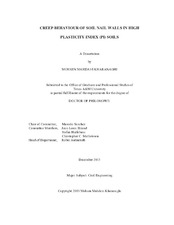| dc.contributor.advisor | Sanchez, Marcelo | |
| dc.creator | Mahdavi Kharanaghi, Mohsen | |
| dc.date.accessioned | 2016-05-04T13:19:03Z | |
| dc.date.available | 2019-12-01T06:35:24Z | |
| dc.date.created | 2015-12 | |
| dc.date.issued | 2015-09-02 | |
| dc.date.submitted | December 2015 | |
| dc.identifier.uri | https://hdl.handle.net/1969.1/156371 | |
| dc.description.abstract | An aspect of particular concern in the soil nail wall manual and construction guideline, Geotechnical Engineering Circular No. 7 on Soil Nail Walls, is the creep behavior of soil nail systems in high-plasticity clays. This research is aimed to gain a better understanding of the long-term behavior of the soil nail walls in fine-grained soil with plasticity index more than 20. Experimental and numerical investigations are performed in this Ph.D. work in the context of a research project funded by Texas Department of Transportation (TxDOT).
Field investigation consisted of pullout tests at the National Geotechnical Experimental Site (NGES) at Texas A&M University; and instrumentation, monitoring and testing at the actual soil nail wall project. The tests at NGES-TAMU were focused on effect of load level on creep behavior of soil nails in a natural clay deposit with high plasticity. The tests were conducted on 10 existing anchors (installed in 1991), 16 new vertical soil nails installed in this research, and 6 sacrificial soil nails installed during the construction of an actual soil nail wall. This wall corresponded to a new project of an excavation wall in an embankment fill, in which 9 permanent soils nails were instrumented with the aim of monitoring the long term behavior of the wall and performance of the nails in high plasticity clays.
Complementary laboratory tests to learn about the creep behavior of clays involved in this research were performed at TAMU using the samples gathered from the field. The main goal of the numerical modeling was to calibrate the constitutive models using the information gathered from the laboratory and pullout tests; and also to simulate the long-term behavior of the actual soil nail. FLAC3D was adopted in this research.
Monitoring the actual soil nail wall and the numerical modeling results revealed that the maximum horizontal deformation of the wall due to the creep of the wall for one year after the construction is less than 10% of the horizontal deformation of the wall soon after the construction. According to GEC#7, the horizontal deformation of the wall after construction usually increases up to 15% compared to the deformation observed soon after construction. As a results of this movement (i.e. due to the post-construction creep movement of the wall), additional tension load is developed in the nails. The maximum additional load in the nail one year after the construction is 50% of the axial load in the nails at the end of the construction for the bottom third of the wall. Even with additional 50% axial load, the axial load in the nails at the bottom third of the wall is less than 30% of the maximum pullout capacity of the nails. | en |
| dc.format.mimetype | application/pdf | |
| dc.language.iso | en | |
| dc.subject | Soil Nail Wall | en |
| dc.subject | Creep | en |
| dc.subject | High Plasticity Clay | en |
| dc.title | Creep Behavior of Soil Nail Wall in High Plasticity Index (PI) Soil | en |
| dc.type | Thesis | en |
| thesis.degree.department | Civil Engineering | en |
| thesis.degree.discipline | Civil Engineering | en |
| thesis.degree.grantor | Texas A & M University | en |
| thesis.degree.name | Doctor of Philosophy | en |
| thesis.degree.level | Doctoral | en |
| dc.contributor.committeeMember | BRIAUD, Jean-Louis | |
| dc.contributor.committeeMember | Hurlebaus, Stefan | |
| dc.contributor.committeeMember | Mathewson, Christopher | |
| dc.type.material | text | en |
| dc.date.updated | 2016-05-04T13:19:03Z | |
| local.embargo.terms | 2019-12-01 | |
| local.etdauthor.orcid | 0000-0002-1824-4906 | |


